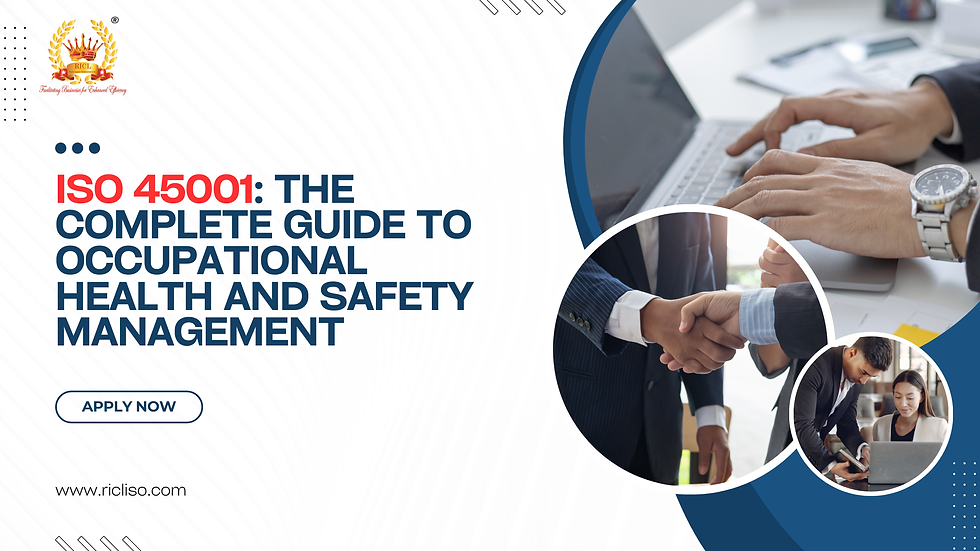ISO 45001: The Complete Guide to Occupational Health and Safety Management
- teamitricl
- Sep 16
- 5 min read

Introduction
In today’s fast-paced and competitive world, ensuring workplace safety is no longer an option—it’s a necessity. Every year, millions of workers are injured, fall sick, or even lose their lives due to workplace-related hazards. Businesses that fail to prioritize health and safety not only face legal risks but also damage their reputation and lose employee trust. This is where ISO 45001, the international standard for Occupational Health and Safety Management Systems (OHSMS), comes into play.
ISO 45001 is designed to help organizations proactively manage risks, reduce accidents, and create a safe working environment. Whether you run a small business or a multinational enterprise, this standard provides a structured framework to protect your workforce and improve performance.
In this comprehensive guide, we’ll dive deep into what ISO 45001 is, its benefits, requirements, certification process, and why it has become the global benchmark for workplace safety.
________________________________________
What is ISO 45001?
ISO 45001 is the international standard for Occupational Health and Safety Management Systems, published by the International Organization for Standardization (ISO) in March 2018. It replaced the older OHSAS 18001 standard and provides a globally recognized framework for improving worker safety, reducing risks, and creating healthier workplaces.
Unlike other safety programs that may only focus on compliance, ISO 45001 takes a proactive and risk-based approach. It requires organizations to identify potential hazards, assess risks, and implement controls before incidents occur.
In short, ISO 45001 is about prevention, protection, and continuous improvement.
________________________________________
Why is ISO 45001 Important?
Workplace injuries, illnesses, and fatalities carry not only human costs but also financial consequences for organizations. Lost productivity, medical costs, legal liabilities, and damaged reputation can harm long-term business sustainability.
ISO 45001 is important because it:
• Establishes a global benchmark for occupational health and safety.
• Provides a structured system for managing risks.
• Protects both employees and organizations from workplace hazards.
• Enhances compliance with legal and regulatory requirements.
• Demonstrates corporate responsibility and commitment to safety.
For companies aiming to win contracts, retain skilled workers, and build strong reputations, ISO 45001 is a strategic advantage.
________________________________________
Key Features of ISO 45001
ISO 45001 introduces several unique features compared to older safety standards:
1. Risk-based approach – Focuses on identifying and controlling risks before incidents happen.
2. Leadership involvement – Requires top management to actively participate in safety programs.
3. Worker participation – Encourages employees at all levels to engage in safety decision-making.
4. Integration with other standards – Follows the High-Level Structure (HLS), making it easy to integrate with ISO 9001 (Quality Management) and ISO 14001 (Environmental Management).
5. Continuous improvement – Promotes ongoing monitoring, measurement, and enhancement of workplace safety.
________________________________________
Benefits of ISO 45001 Certification
Organizations that adopt ISO 45001 gain multiple benefits beyond compliance. Some of the most significant advantages include:
• Reduced workplace accidents and incidents – Lower injury rates and improved worker well-being.
• Compliance with laws and regulations – Stay ahead of legal requirements and avoid penalties.
• Increased employee trust and morale – Workers feel valued when their safety is prioritized.
• Improved reputation – Customers, partners, and stakeholders view certified organizations as responsible.
• Lower insurance costs – Fewer accidents often lead to reduced insurance premiums.
• Business growth opportunities – Many contracts, especially with governments and large corporations, require ISO 45001 certification.
• Operational efficiency – A structured system reduces downtime, disruptions, and hidden costs.
________________________________________
ISO 45001 Structure (High-Level Framework)
ISO 45001 is based on the Annex SL High-Level Structure, ensuring consistency with other ISO management system standards. The structure includes:
1. Scope – Defines the boundaries of the OHSMS.
2. Normative References – Standards and documents referenced.
3. Terms and Definitions – Key terminology.
4. Context of the Organization – Internal and external factors affecting safety.
5. Leadership and Worker Participation – Roles of management and employees.
6. Planning – Risk assessment, hazard identification, and objectives.
7. Support – Resources, training, awareness, communication, and documentation.
8. Operation – Risk controls, emergency preparedness, and operational planning.
9. Performance Evaluation – Monitoring, audits, and compliance checks.
10. Improvement – Corrective actions and continual development.
________________________________________
ISO 45001 Requirements
To achieve certification, organizations must implement specific requirements, including:
• Hazard identification and risk assessment – Recognizing potential dangers in the workplace.
• Legal and compliance obligations – Meeting local and international regulations.
• Objectives and performance metrics – Setting measurable safety goals.
• Roles and responsibilities – Defining accountability across the organization.
• Training and awareness programs – Ensuring workers are educated and competent.
• Emergency preparedness – Planning for accidents, disasters, or unexpected events.
• Incident investigation and reporting – Learning from accidents to prevent recurrence.
• Internal audits and management reviews – Regularly checking system effectiveness.
________________________________________
ISO 45001 Certification Process
The journey to certification typically follows these steps:
1. Gap Analysis – Review current safety practices compared to ISO 45001 requirements.
2. Planning – Develop an implementation plan with timelines and responsibilities.
3. Implementation – Put safety procedures, policies, and controls into action.
4. Training & Awareness – Educate employees and managers about the system.
5. Internal Audit – Conduct internal reviews to check readiness.
6. Management Review – Senior leadership evaluates system effectiveness.
7. Certification Audit – An accredited external body audits the organization.
8. Certification Awarded – Upon successful audit, certification is granted.
9. Ongoing Surveillance Audits – Regular follow-up audits to maintain certification.
________________________________________
ISO 45001 vs. OHSAS 18001
Before ISO 45001, the most widely used standard was OHSAS 18001. However, ISO 45001 has several improvements:
• International recognition – ISO 45001 is a globally adopted ISO standard.
• Risk-based approach – Stronger emphasis on proactive risk management.
• Integration – Aligns with ISO 9001 and ISO 14001 for seamless management systems.
• Leadership role – Requires greater involvement from top management.
• Worker participation – Encourages employee involvement in all safety processes.
Organizations that were previously certified to OHSAS 18001 were required to migrate to ISO 45001.
________________________________________
Industries That Benefit from ISO 45001
ISO 45001 applies to all industries, regardless of size or type. However, it is especially valuable for sectors with high-risk environments, including:
• Construction
• Manufacturing
• Oil and Gas
• Healthcare
• Mining
• Transportation and Logistics
• Food Processing
• Utilities and Energy
Even low-risk industries such as IT, finance, or retail can benefit by showing commitment to employee well-being.
________________________________________
Common Challenges in Implementing ISO 45001
While ISO 45001 offers tremendous benefits, organizations may face some challenges, such as:
• Resistance to change – Employees and managers may hesitate to adopt new processes.
• Cost of implementation – Initial investment in training, audits, and improvements.
• Complex documentation – Developing and maintaining policies and procedures.
• Maintaining employee engagement – Ensuring participation from all levels of staff.
• Continuous monitoring – Requires ongoing effort, not a one-time activity.
These challenges can be overcome through effective communication, leadership commitment, and proper training.
________________________________________
Future of ISO 45001
Workplace safety is an evolving field, and ISO 45001 will continue to adapt to new challenges. Future trends may include:
• Integration of digital tools and AI for safety monitoring.
• Greater focus on mental health and well-being.
• Stronger emphasis on remote work safety measures.
• Advanced data analytics for risk prediction.
Organizations that adopt ISO 45001 today are better positioned to adapt to future safety and regulatory requirements.
________________________________________
Conclusion
ISO 45001 is more than just a certification—it’s a commitment to protecting lives. By adopting this international standard, organizations can reduce risks, improve compliance, boost reputation, and foster a culture of safety.
In an era where businesses are judged not only by their profits but also by their social responsibility, ISO 45001 stands as a powerful tool to showcase dedication to employee welfare.
Whether you are a small business or a global enterprise, implementing ISO 45001 is an investment that pays off in safer workplaces, happier employees, and sustainable growth.






Comments